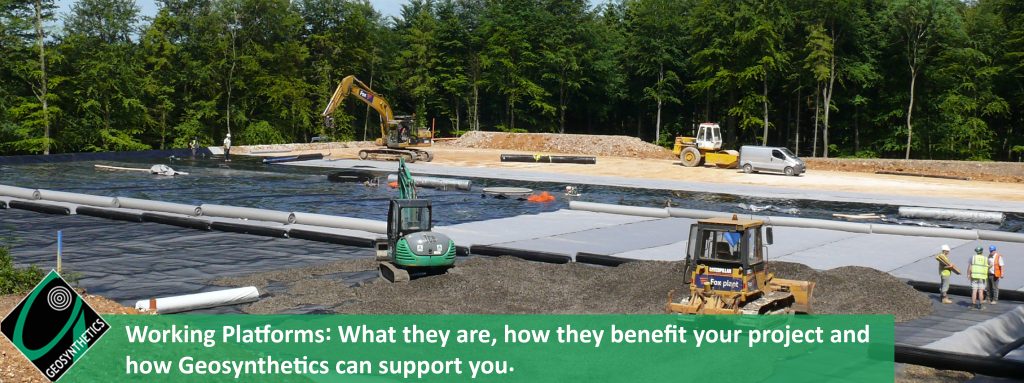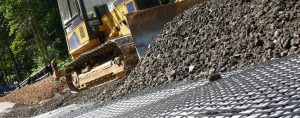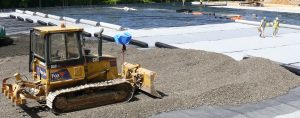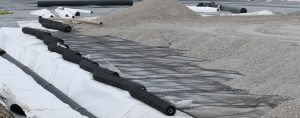News

Working Platforms: What they are, how they benefit your projects and how Geosynthetics Ltd can assist.
What is piling and why is it used?
Piling is a type of deep foundation, used to transfer load to a deeper level where a traditional shallow foundation would be inadequate for the in-situ ground conditions. Vertical columns of concrete, steel or sometimes wood, are driven deep into the ground to give extra support to the building that sits on top. The loads are transmitted through the pile either by ‘end bearing’ to a firm stratum beneath, or ‘friction’ through the sides of the piles to the surrounding soils, or a combination of both.
Piling is now one of the most common construction techniques, but when did the process actually come into existence?
It is actually estimated that piling techniques date back to the 4th Century BC. Herodotus, the Greek writer and traveller, sometimes referred to as the father of history, records how Paeonians lived in dwellings that were erected on lofty piles that were driven into a lake bed.
The History ….
Piling has been referred to in a number of different texts throughout history. Swiss dwellers referenced a piling technique when referring to lake dwellers who lived around 6,000 years ago and built structures on piled foundations to elevate their dwellings to protect against attack.
Along the Mediterranean coast, Greek and Roman engineers during ancient times used piles for most shore works. In Britain, a Roman bridge spanning the Tyne at Corbridge, 20m West of Newcastle Upon Tyne, was built using a piling support structure. Another bridge across the Thames, in AD60, was also built using timber piles driven into the river bed.
There is a lot of evidence of piling existing in structures all over the world, testifying to the skills of ancient builders and engineers. Romans can be credited as the forerunners of modern-day piling techniques, as the cities of Ravenna and Venice are some of the oldest examples of their use of piling, with some still existing today.
There are a number of types of pile but Geosynthetics Ltd can assist you and your project with them all, we’ll explain exactly how later ….
- Bored piles – these are installed by auguring into the ground, forming a hole into which concrete can be poured, thereby casting the pile in position. This method of piling is well suited for work in cities and areas surrounding existing buildings as the vibration caused by installation is minimised
- Driven piles – these are driven or hammered into the ground with the use of vibration. This method of piling is well suited for foundations in non-cohesive soils, ground with a high water table, and for soils that contain contaminates.
- Screw piles – these use circular hollow galvanised steel pile shafts with one or more steel helices attached to them, and are fastened into the ground much like a screw is fastened into wood.
- Sheet piles – these are a type of ‘driven’ pile, and are constructed from a series of interlocking steel sheets. Sheet piles can be used to create temporary or permanent retaining walls where large excavations are required
- Mini piles – these typically range in diameter from 100-400mm and are often used in locations with tight or restricted access which prohibit the use of more typical piling rigs.
The Piling Platform and how Geosynthetics Limited comes in to the equation ….
Working/piling platforms are used to provide a safe and durable surface from which heavy plant such as piling rigs and cranes can operate. They are formed from placing and compacting a calculated depth of granular stone. The interlocking mechanism of the compacted stone layer creates a ‘load spread’ angle which dissipates the load from the piling rig, or construction plant, above so that the, often marginal, bearing capacity of the in-situ beneath is not exceeded.
Maximising sustainability and minimising our environmental impact should always be at the forefront of what we in the construction industry strive for. In turn this often minimises the commercial costs, always of interest, and not least in the current climate where quarried aggregate prices have already increased several times this year alone!
And this is where Geosynthetics Limited with their specialist products, available from UK stock, and ‘In-House’ technical capability comes to the fore.
The specific design of a working platform will vary greatly dependant on a number of factors including underlying soil conditions, loading requirements and type of granular soil being used. However, by incorporating a High Modulus bi-axial geogrid within the working platform, additional lateral restraint and mechanical interlock is generated throughout the compacted granular stone. Put simply, this increases the load spread angle though the platform meaning that the stone depth required can be reduced.
By being at the forefront of current design methodologies, and by utilising the particular benefits of their High Modulus bi-axial geogrids, Geosynthetics Limited’s ‘In-House’ Civil Engineers can often reduce the depth of a platform by 30-50% compared to a ‘traditional’ un-reinforced equivalent!
The benefits of such a saving are numerous – less virgin quarried stone, less dig out and costly potential muck away, lower carbon footprint, faster install times, less machine time and fuel, fewer vehicle movements on neighbouring roads, less disruption to surrounding businesses/residents etc. All in all a ‘win-win’ from environmental, sustainability and commercial perspectives.
A ‘FREE’ site specific Technical Recommendation from Geosynthetics Limited’s Engineers will consider the specifics of the existing site materials, and bearing capacity required by the specific construction plant to be used in various modes of operation to Value Engineer the best possible solution for the scheme. Typically a working platform will feature Tenax High Modulus geogrids in conjunction with Ekotex non-woven geotextiles to stabilise the granular material ready for use.
Having a range of geogrids and geotextiles available from stock allows Geosynthetics Limited to design and deliver the best possible solution very efficiently without adverse impact to often tight construction programmes.
Geosynthetics Limited offers free Technical Recommendations, preliminary calculations and training seminars. To get technical advice or to book a seminar please contact the sales office on 01455 617139 or email sales@geosyn.co.uk.




